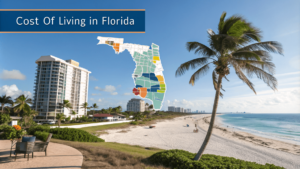Key factors influencing the cost of building a house in Florida include location (land prices, site conditions), materials (hurricane resistance, supply chain), labor (shortages, specialized skills), permits/fees, and design choices. These factors impact budget optimization, risk management, and market awareness. Florida’s average construction cost is $150 per square foot, higher than the national average, due to climate-related needs.
This blog post will guide you into the key factors affecting the cost of building a home in Florida, ranging from location and materials to labor and permits. It provides actionable insights, real-world examples, and data-driven analysis to help you navigate this process effectively. Key takeaways include strategies to manage costs, the impact of Florida’s unique climate, and how current real estate market trends play a role.
Table of Contents
ToggleKey Cost Factors for Home Construction in Florida
Location
Location is one of the most significant drivers of home construction expenses in Florida.
-
- Land Prices: Urban areas like Miami or Tampa can have land costs upwards of $500,000 per acre, while rural zones like Ocala may offer land for as little as $50,000 per acre.
- Site Conditions: Coastal areas often require additional construction measures such as flood-proofing and storm surge mitigation.
- Zoning Laws: Regulations vary by municipality and can impact construction style, building height, and property tax implications.
Materials
Florida’s hot, humid, and storm-prone environment requires builders to use durable, often premium materials.
-
- Concrete and Steel: Preferred for their durability in high-humidity and high-wind conditions. Concrete costs average $125 per yard in Florida, slightly above national figures.
- Hurricane-Resistant Features: Items like impact-resistant windows and reinforced roofs can increase total construction costs by 10% to 20%.
- Supply Chain Disruptions: Recent disruptions have increased the cost of lumber by 35% over the past two years. This rise in material costs can affect the overall mortgage payments and down payment amounts, especially for first-time homebuyers.
Labor
Labor availability and specialization significantly affect costs.
-
- Shortages: Florida has a documented shortage of skilled construction workers. As a result, the average hourly wage is about $21, compared to $18 nationally.
- Specialized Skills: Workers trained in hurricane-resistant construction or energy-efficient systems typically charge more, but their expertise ensures regulatory compliance and long-term savings.
Permits and Fees
Local and state regulations impose several required fees.
-
- Building Permits: Typically range between $1,000 and $3,000, based on project scope.
- Impact Fees: These can add $10,000 to $20,000 to your overall budget in growing areas. Understanding these fees is crucial for financial planning.
Design Choices
The design and complexity of your home also impact your budget.
-
- Custom vs. Pre-Designed: Custom-built homes demand unique materials and labor, increasing costs per square foot.
- Size and Layout: Larger homes and complex designs naturally increase material and labor costs, impacting mortgage pre-approval and interest rates.
Why These Factors Matter
Understanding what influences construction costs helps Florida homeowners in three critical ways:
-
- Budget Optimization: Strategic planning, such as opting for modular construction or using locally sourced materials, can reduce expenses by 15–20%.
- Risk Management: Investing in hurricane-proof materials may increase upfront costs but significantly reduce damage and insurance premiums in the long run.
- Market Awareness: Keeping up with trends like labor shortages and material prices allows you to time your project better and avoid unnecessary expenses.
Real-Life Examples
-
- Material Optimization: A homeowner in Orlando sourced concrete locally and saved 12% on their build by avoiding transport fees.
- Location Strategy: Building inland in Gainesville instead of Tampa reduced the need for expensive hurricane-proofing, cutting costs by 15%.
- Smart Design: A family in Miami chose an open floor plan, which reduced the need for interior walls and saved 8% on labor.
Frequently Asked Questions
What is the average cost per square foot to build a home in Florida?
Florida’s average cost is $150 per square foot, which is higher than the national range of $100–$120 due to climate-related construction requirements.
How much do hurricane-resistant features add to the cost?
Expect to pay 10–20% more for features like reinforced roofs and impact windows in high-risk areas.
What’s the impact of permits and fees on the total budget?
Permits and impact fees can account for 10–15% of the total building cost, especially in fast-growing counties.
Final Thoughts
Whether you’re building in South Florida or the Panhandle, understanding the key drivers behind home construction costs is essential. Factors like land price, material resilience, labor availability, and regional regulations all play a role. With the right planning, you can minimize risks, optimize your budget, and turn your Florida dream home into a reality.
To make the most of your project:
-
- Consult local experts for region-specific costs.
- Consider alternative building methods.
- Stay updated on real estate and construction trends.
By approaching the process with data and foresight, you’ll not only control your costs but build a home that’s both beautiful and durable.

